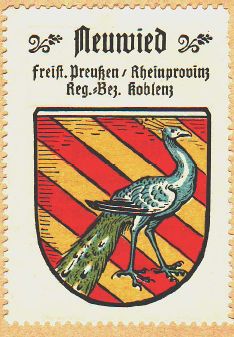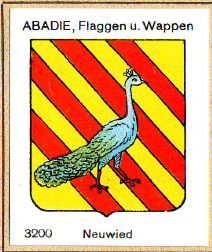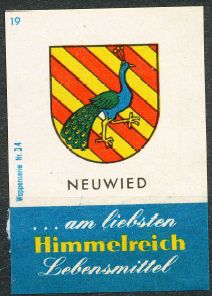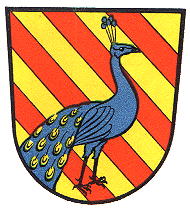Neuwied: Difference between revisions
Knorrepoes (talk | contribs) m (Text replacement - "/Arms of " to "/Arms (crest) of ") |
Knorrepoes (talk | contribs) m (Text replacement - "{{media}}" to " {{de1}} {{media1}}") |
||
| Line 36: | Line 36: | ||
|} | |} | ||
{{ | |||
{{de1}} | |||
{{media1}} | |||
[[Civic Heraldry Literature - Germany|'''Literature''']]: Stadler, 1964-1971, 8 volumes; Hupp, O: [[Kaffee Hag albums]], 1920s | [[Civic Heraldry Literature - Germany|'''Literature''']]: Stadler, 1964-1971, 8 volumes; Hupp, O: [[Kaffee Hag albums]], 1920s | ||
Revision as of 10:53, 26 December 2022
This page is part of the German heraldry portal Deutsche Wappensammlung |
Heraldry of the World |
|
German heraldry:
|
Selected collector's items from Germany:
|
NEUWIED
State : Rheinland-Pfalz
District (Kreis) : Neuwied
Additions : 1904 Heddesdorf; 1969/1970 Altwied, Engers, Feldkirchen (Rhein) (1966 Fahr, Gönnersdorf, Hüllenberg, Rockenfeld, Wollendorf), Gladbach, Heimbach-Weis (1960 Heimbach, Weis), Irlich, Niederbieber-Segendorf, Oberbieber
| German | |
| English | No blazon/translation known. Please click here to send your (heraldic !) blazon or translation |
Origin/meaning
Neuwied was founded as a city by the Counts of Wied in 1653. The oldest seal dates from 1681 and shows the arms of the Counts of Wied, a shield with 4 red bends and a peacock. In the 19th century the peacock was often shown in natural colours, but otherwise the peacock has always been blue.
The arms are known for the Counts of Wied since the early 13th century, their meaning is not known. Until the 1970s the arms only showed the peacock, see below.
| Seal from around 1900 |
The arms by Hupp in the Kaffee Hag albums +/- 1925 |
| The arms in the Abadie albums |
Local emergency money with the arms from 1921 |
| The arms on a 1960s matchox label |
Arms according to Stadler, 1960s |
Literature: Stadler, 1964-1971, 8 volumes; Hupp, O: Kaffee Hag albums, 1920s








